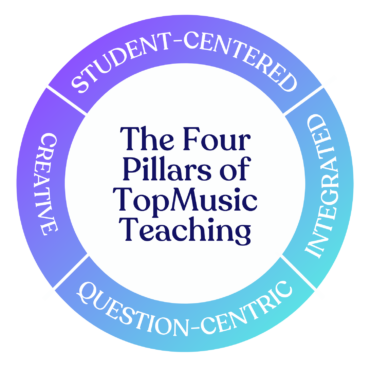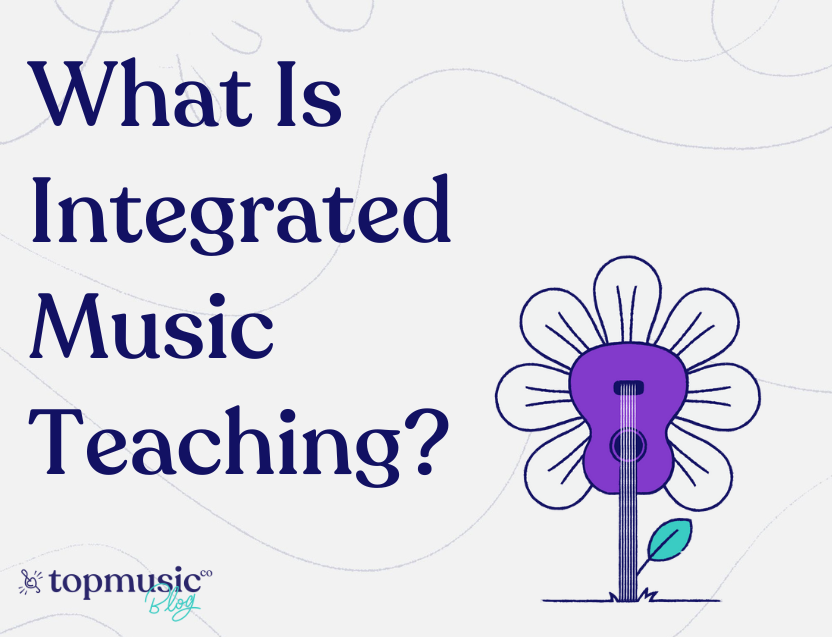Integrated Music Teaching is at the heart of everything at TopMusic. But what exactly is it? We sat down with the main man himself, Tim Topham, to ask him.
Table of Contents:
Integrated Music Teaching is a way of teaching that endeavors to always help music students see and understand the connections between musical experiences and elements.
For example, the connections between keys, chords, scales, progressions, patterns, pop and classical music, theory, and practice.
We’re not giving you pre-written lesson plans or concrete ways of how you should teach certain things.
Instead, we’re showing you how you could teach the things you’re already teaching in a way that helps your students make deep connections.
We’re giving you ideas on how you can link musical elements in your students’ repertoire by using creative ‘integration’ activities.
Indeed, we believe integrated teaching is important enough that it’s one of the four TopMusic Teaching Pillars:

All four pillars work together to form a truly integrated, comprehensive, and holistic approach to your lessons.
Related: Integrated Music Teaching.
Exactly. Connections are key.
Rather than a lesson following:
“Hi! Play me your scales. Now, let’s work on a piece. Great, let’s play through your next piece. We have just enough time for your third piece. Brilliant job, see you next week.”
Make connections.
Why are you asking them to learn that D major scale? Oh, because this piece is in D major. Have them play the scale and then look at the piece to see if any sections feature a scale pattern.
Bring up the circle of fifths and work out the primary triads in D major: D, A, G. Take those triads and create an improvisation. Stick on a backing track.
See if they can find the primary triads in action in the piece. How do they appear? Is that similar or different to another of their pieces?
Try to find and make connections between everything they do.
Related: Engaging Intermediate Students with an Integrated Approach
If you feel confident doing that, then go for it!
Otherwise, I suggest following the 3-Step Process:
Related: 3 Steps to Teaching an Integrated Music Lesson
No, that’s the great thing. When you run a linear, disconnected lesson, there’s never enough time for everything because you constantly have to shift to new activities.
That means that things like sight reading, theory, aural tests, singing, etc., are often forgotten until the week or two before an exam.
When you integrate and help students see these connections, you can cover multiple bases at the same time. For example, you can work on aural and rhythm skills while you’re exploring a pop song pattern or chord progression.
Sight reading can be improved because when you unpack the chord structure of a piece in a particular key, students can apply that to future pieces (or even their own compositions) in that key.
Integrating should actually save you time in the long run!
Related: Integrated Music Teaching in Action
That’s OK. Not every student will jump at creativity at first. Creative activities are some of the best ways for students to form memories because they tend to be memorable and unique (or “novel,” as Dr Anita Collins says in the research).
So for students who are a little timid, just start small and simple. The more parameters (ie. “restrictions”) you put in place when asking students to create something (eg. improvising), the easier it becomes. Eg. just one chord or just one note.
The more creative activities you integrate into a lesson, the more normalized this will become. So, while you may have some reticence at the start, many students will feel more comfortable over time.
But rest assured that, even if all you do is analyze the scores, show the students the connections, and incorporate as much theory into the practice of playing as possible, you’ll be way ahead of 90% of teachers!
Related: How to teach an integrated music lesson.
If a student is getting confused then that’s a sign you’re going too far and it defeats the purpose of IMT.
You don’t want to overwhelm your students, so if you sense this happening, just back off and focus more on the music for a while.
Then, slowly bring small things back in: “…did you notice that this is the same as that passage in that other piece?” or “… can you hear that this is a pentatonic melody? Can you play the pentatonic scale?”
Related: Introduction to Integrated Music Teaching
Like I’ve said before, students love seeing their teachers learning; part of learning is making mistakes.
Good teachers are no longer the ones who have all the answers, never falter, and teach the same thing year after year. No!
You want to be the teacher who learns and tries new things, and your students will respect that.
So if this happens to you, just say either, “That’s a great question. Can I get back to you next week?” or, if you have time: “What a great question – why don’t we look it up now?”Show them that you’re learning together.
Related: What YOU think about IMT
If you’d like a more in-depth breakdown of Integrated Music Teaching, including practical ideas, download our FREE TopMusicMag: Integrated Music Teaching special.
